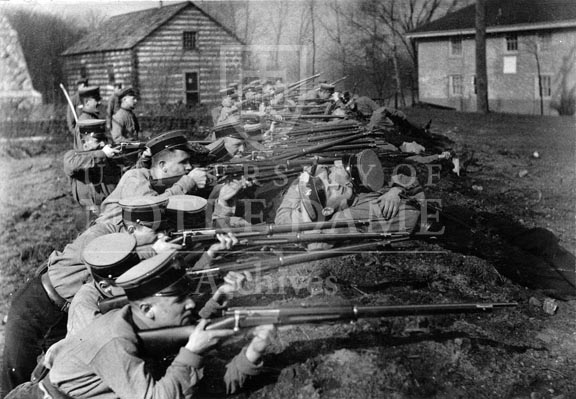
Notre Dame has had a long military tradition. The administration organized student military units early on as a means of encouraging physical activity, leadership, and discipline. In 1859, a company of students were organized under the name “Continental Cadets.”

During the Civil War, many Holy Cross priests, brothers, and sisters served as chaplains and nurses. Most notable of these was Rev. William Corby, who gave absolution to the troops of the Irish Brigade before battle at Gettysburg. Rev. Edward Sorin worked hard to make sure the Holy Cross clerics weren’t conscripted into actual fighting and gained support from Generals William Tecumseh Sherman and Ulysses S. Grant. Not only did bearing arms conflict with the vocation of the religious, Notre Dame could ill afford to loose so many clerics and still remain functional as a university. While the Notre Dame company did not serve as a whole unit, many individual students and alumni took up arms in the Civil War — most for the Union, but some for the Confederacy.

Seated (left to right) Brother Leander (James McLain), Lieutenant Colonel W.A. Olmstead, Rev. William Corby, CSC, Rev. Peter Paul Cooney, CSC, Brother John Chrysostom, CSC (Mark A. Wells)
Standing (left to right): Brother Benedict, CSC (James Mantell?), Brother Ignatius, CSC (Ignace Meyer), Colonel William Hoynes, Brother Raphael, CSC, Brother Cosmos, CSC (Nicholas A. Bath), Brother Eustachius, CSC (John McInerny)
After the Civil War, interest in student military organizations on campus ebbed and flowed. In the 1880s, the a company in the senior department organized under the name “Hoynes Light Guards,” while the junior department were called “Sorin Cadets.”

In 1898, two-hundred and fifty students organized to be prepared to volunteer for the Spanish-American War. Often drilling with the military units, “The university band will also be prepared to go.” [PNDP 30-Mi-02; Catholic News, NY, NY, 04/03/1898]
In 1910, the United States War Department sent retired Captain R.R. Stogsdall to Notre Dame to officially teach military tactics and instruction on campus. This appointment moved Notre Dame toward having more professionally organized military companies. Boys under the age of 17 were required to participate in such companies, while it was voluntary for collegiate-level students.
The onset of World War I brought about much militarist patriotism among Notre Dame students, faculty, and clergy. Participation among students still remained voluntary, yet the companies swelled in number. Rev. Matthew Walsh and Rev. Charles O’Donnell, both later University Presidents, served as chaplains. O’Donnell’s helmet hangs in the War Memorial entrance to the Basilica of the Sacred Heart.

with the Log Chapel and Old College in the background, 1915-1916.
This photo was published in the 1916 Dome yearbook, page 184.
Notre Dame’s relationship with the Navy began in 1927 and strengthened when University President Hugh O’Donnell “offered all of the facilities of this institution to the government. In April of 1943 the V-7 Indoctrination School was created and the first group of 900 men, all college graduates enlisted for one month as apprentice seamen.” [PNDP 30-Mi-02; “Notre Dame’s Naval ROTC Unit,” Notre Dame, Fall 1959]. The relationship with the Navy helped to sustain Notre Dame at a time that was economically dire for the entire country.

After World War II, such intense military training ended at Notre Dame. In the 1950s, the Reserve Officer Training Corps (ROTC) was established at Notre Dame. However, student sentiment towards the military heated up with the rest of the country during the Vietnam War in the 1960s and 1970s.

Notre Dame’s relationship with the military, its supporters and detractors, have historically reflected national sentiment and will probably continue to do so. Notre Dame is one of a few universities with a ROTC program currently represented by all branches of the military — Army, Navy, Marines, and Air Force. Today we honor those veterans who have served our great country, particularly the sons and daughters of Notre Dame.

Sources:
Dome yearbook
PNDP 30-Mi-02, including the following articles:
—St. Joseph County Forum, June 18, 1859
–Letter to Abraham Lincoln from Fr. Sorin, September 28, 1863
—Catholic News, NY, NY, 04/03/1898
–“US Army Man to Drill Notre Dame Students,” South Bend Tribune, July 9, 1910
–“Notre Dame Classes Largest in History,” South Bend Times, September 20, 1910
–The Army Reserve Officer Training Program: A Century’s Development at Notre Dame,” Notre Dame, Summer 1959
–“Notre Dame’s Naval ROTC Unit,” Notre Dame, Fall 1959
–“Notre Dame and the Draft,” by Virgil L. Levy, Lincoln Herald, Summer 1977
“God? Country? Notre Dame?,” by John Monczunski, Notre Dame Magazine, Spring 2001
GFCL 49/20
GSBB 2/07
GMIL 1/09
GDIS 22/49
GNDL 8/41
GMDG 12/34
For more information about Notre Dame in the Civil War, see also Blue for the Union and Green for Ireland: The Civil War Flags of the 63rd New York Volunteers, Irish Brigade, by Peter J. Lysy, Archivist, University of Notre Dame; as well as the blog and new book by James M. Schmidt: http://notredamecivilwar.blogspot.com/

3 thoughts on “The Military at Notre Dame”
Comments are closed.